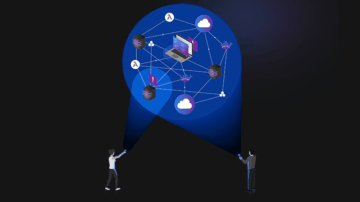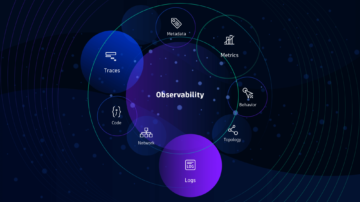
Full-stack observability is fast becoming a must-have capability for organizations under pressure to deliver innovation in increasingly cloud-native environments.
As organizations grapple with mounting cloud complexity, IT teams know they must identify and respond to evolving issues across the entire technology stack—from mainframes to multicloud environments.
What is full-stack observability?
Full-stack observability is the ability to determine the state of every endpoint in a distributed IT environment based on its telemetry data. Endpoints include on-premises servers, Kubernetes infrastructure, cloud-hosted infrastructure and services, and open-source technologies. Observability across the full technology stack gives teams comprehensive, real-time insight into the behavior, performance, and health of applications and their underlying infrastructure.
A full-stack observability solution uses telemetry data such as logs, metrics, and traces to give IT teams insight into application, infrastructure, and UX performance. This crucial context also enables teams to understand how all entities are connected. Not just infrastructure connections, but the relationships and dependencies between containers, microservices, and code at all network layers.
Comprehensive observability is also essential for digital experience monitoring (DEM). Observability can identify the baseline user experience and allow teams to improve it by optimizing page load times or reducing latency. When you can quickly resolve issues, you can enhance the customer experience (CX) and ensure a steady flow of revenue.
Why full-stack observability matters
Cloud environments present IT complexity challenges that don’t exist in on-premises data centers. In response, many organizations add more monitoring tools, which adds to cloud complexity and slows down timely responses to issues.
Because teams often use multiple tools in separate silos, they lack a full picture of activity. Without a single source of truth, teams often wrestle with competing answers. As a result, they may struggle to resolve or even agree on the root causes of urgent issues that affect business revenue.
Observability provides insight into each layer of application infrastructure using one platform and simplifies this monitoring tool sprawl. As a result, teams can avoid the costs and confusion of having multiple point solutions that potentially provide conflicting answers. You can also prevent war rooms and blame that can affect morale and keep teams from aligning on common goals.
DevOps teams can also benefit from full-stack observability. They can get accurate, real-time feedback from integration or production systems, resolving UX issues and application performance challenges more quickly. With improved diagnostic and analytic capabilities, DevOps teams can spend less time troubleshooting. Instead, they can apply their talent to developing innovative new features that benefit users and move the business forward.
How full-stack observability enhances IT and DevOps
Here are a few ways full-stack observability can benefit your IT and DevOps teams.
Gain situational awareness of an entire multicloud environment
Without full observability of an organization’s entire multicloud environment, you have, at best, a partial understanding of your application infrastructure. Observability provides end-to-end visibility across an entire application environment, eliminating blind spots surrounding application performance, health, and behavior.
Pinpoint precise root causes and prioritize issues
Rather than wasting time sifting through the noise and interpreting statistics, IT and DevOps teams can use observability to quickly identify root causes and prioritize issues according to user and business impact. Some organizations that use an observability platform see a 90% reduction in time-to-respond.
Accelerate and automate the CI/CD pipeline
Full-stack observability helps DevOps teams quickly identify potential issues in the CI/CD pipeline, fixing problems with greater speed and confidence. This can help accelerate and automate software development and delivery enabling organizations to innovate faster and stay competitive.
Integrate run-time application security into DevSecOps
Because security teams must manage risk, other IT teams can perceive them as innovation roadblocks. Full-stack observability eliminates this common challenge by allowing IT teams to integrate runtime application security more effectively into DevSecOps processes. This integration ensures that teams stay on track with ambitious growth goals without compromising security.
Improve business decisions with precision analytics
When IT and business teams aren’t aligned, it’s difficult for organizations to make important decisions. Observability provides the transparency needed for everyone to have a shared frame of reference and agree on business priorities.
Eliminate operational silos and improve cross-functional collaboration
With a single source of truth for root-cause analysis, IT and DevOps teams can quickly get on the same page about what needs to be done and who’s responsible for doing it. This reduces finger-pointing and eliminates war rooms, improving collaboration and cross-functional working relationships.
An automatic and intelligent approach to full-stack observability
Cloud complexity has made full-stack observability difficult — but it doesn’t have to be that way. With a single platform that automates monitoring across the technology stack, you can get all the operational and business performance metrics you need, from front end to back end and everything in between.
Once you’ve collected all the telemetry you need, deterministic AI can quickly highlight what matters and why, so you can take informed action. Using AI for IT operations (AIOps) can help you not only cut through the noise in IT operations but also increase IT efficiency and innovate faster. AIOps can also provide automated root cause analysis so IT teams can focus their attention on higher-order tasks rather than troubleshooting.
Full-stack observability lets you see it all, top to bottom, from end-user experience to infrastructure health. It also helps you understand how everything is connected — including all the relationships and interdependencies between any layers, components, or pieces of code. These capabilities can help your business digitally transform faster, easier, and smarter — even as cloud complexity increases.
To learn more about how Dynatrace simplifies full-stack observability, download the eBook Observability and beyond for the modern cloud.


